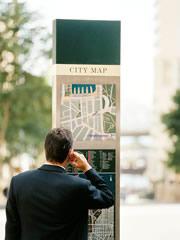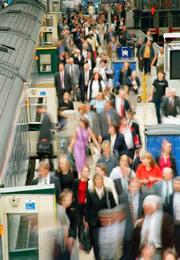 Time to hail a taxi?© Alamy
Time to hail a taxi?© AlamyIt was in Los Angeles that I came to value London cabbies. In Pasadena, to be precise, where my cab driver seemed never to have heard of that minor institution called the California Institute of Technology.
To be a licensed cabbie in London, you have to demonstrate mastery of 'the Knowledge': a detailed grasp of the 25,000 streets within a six-mile radius of Charing Cross, along with all landmarks, public buildings and so forth.
Legend has it that the Knowledge was introduced after the Great Exhibition in 1851, when it transpired that many horse-cab drivers could not find their way to Hyde Park.
Since reading the work of Martin Rosvall, my admiration for those with the Knowledge is even greater.
Rosvall, of Umeå University in Sweden, and his co-workers have tried to figure out why it is so hard for us to find our way around cities. Of course, the obvious answer is that cities have a lot of streets. And particularly if you live in an old city like London or Athens, those streets are messily arranged. But it turns out that the problem is a lot worse than that.
All nodes lead to roam
One way of gauging the complexity of a city is to ask how many directions you would need to get around. This need not be a function of distance: major arteries through a city can channel you efficiently between remote locations. In terms of information, any road off such a main highway is the same distance away from a particular point as any other ('second on the left' is no more complex an instruction than 'tenth on the left').
 New arrivals beware – you could be lost before you know it.© Alamy
New arrivals beware – you could be lost before you know it.© AlamyTo analyse cities in terms of the amount of information required to navigate them, Rosvall and colleagues took street plans of several cities and translated them into information networks, in which streets become nodes connected to other nodes. So long roads with many intersections become hubs with many connections.
They compared these networks with "randomized" versions of the cities, which had the same number of connections but nodes that were connected at random. Their work is preprinted on Arxiv1.
The real cities were consistently harder to navigate than the randomized ones; in other words the 'search information' needed on average to navigate between two points is consistently larger for real cities. There really does seem to be a property, peculiar to cities, that makes them harder to find your way around than other types of network.
Of course the researchers found differences between cities as well. As you might expect, Manhattan, with its chequered grid plan, proves easier to navigate than the three, less orderly Swedish cities considered (Stockholm, Malmö and Umeå). But even Manhattan is more complex, by these measures, than the network formed by flights between US airports.
The crucial characteristic that complicates cities seems to be their inhomogeneity. A random network is more or less equally random everywhere. But cities, especially ones with a long history, have local "islands" of dense interconnections, containing streets that are hidden away in corners.
Tale of two cities
Another revealing way to analyse the structure of cities is to look at their 'lines of communication'. Rui Carvalho and Alan Penn, at University College London, have analysed city maps according to networks of 'axial lines'. These are lines drawn on a street plan: you start with the longest straight line that it is possible to draw and continue to draw gradually shorter lines along the roads, each line extending until it crosses an existing line.
Carvalho and Penn found that plots of the lines' lengths against their rank (longest, second longest and so on) tend to fall on one of two master curves, which delineate two distinct types of city2. One class has a dense structure dominated by short, local routes; the other has many more city-spanning global thoroughfares.
The former class includes old cities such as London, Istanbul and Athens; the latter has newer cities or ones that have been extensively remodelled, such as Denver, Seattle, Tokyo or Bangkok. The distinction seems to boil down to the role that large-scale planning had in the city's development. Rosvall and his team have only analysed a few cities so far, but the differences they see between Manhattan and the Swedish cities may be representative of this more fundamental principle.
The master plan
So is it better to plan the structure of cities or not? Ease of navigation could certainly be seen as a benefit, although that was not necessarily the motivation for some grid-like plans. Several imperial Roman cities were constructed using this scheme because it made them quicker to build, which was an important factor for places that began as military encampments. Such grids can also be found in the cities of ancient Babylonia and Assyria, and in ancient Greece, where they signified an intrinsic reverence for geometry.
Cities like London or Istanbul, on the other hand, have scarcely been touched by any global vision. Christopher Wren's dream of introducing European-style grand avenues to London's chaos after the Great Fire of 1666 was soon stymied as the indefatigable citizens reconstructed their dwellings along the lines of the old streets. This makes for a certain convoluted charm, but is also why the Knowledge is so damned hard to acquire.

